Chinese air defense systems in the Korean War
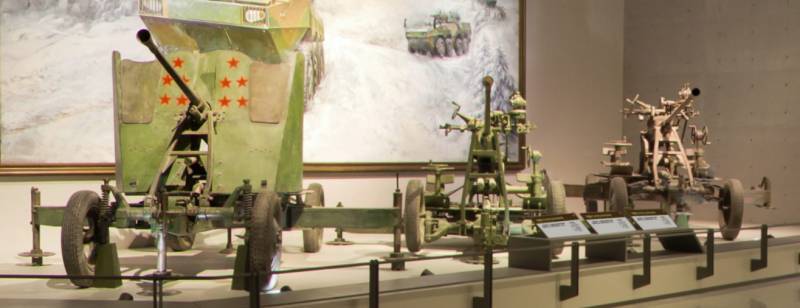
After the liberation of the territory of China from the Japanese invaders, peace did not come to the country. The former allies - the Kuomintang and the Communist Party - clashed in mortal combat.
The US supported the Chinese nationalists right up to their flight to Taiwan. The best material and technical equipment of the Kuomintang troops up to a certain point allowed them to take over the armed formations of the Chinese communists. However, the support of a large part of the population in the countryside and assistance from the USSR allowed the CCP to change the balance of power and achieve victory in the civil war.
Due to the fact that the Chinese communists had almost no military aviation, the anti-aircraft guns available to the Kuomintang were used exclusively against ground targets. At the first stage, anti-aircraft units in the CPC troops were almost completely equipped with captured Japanese anti-aircraft guns, which were actively used both against Kuomintang aviation and to provide fire support to ground units.
Anti-aircraft machine guns
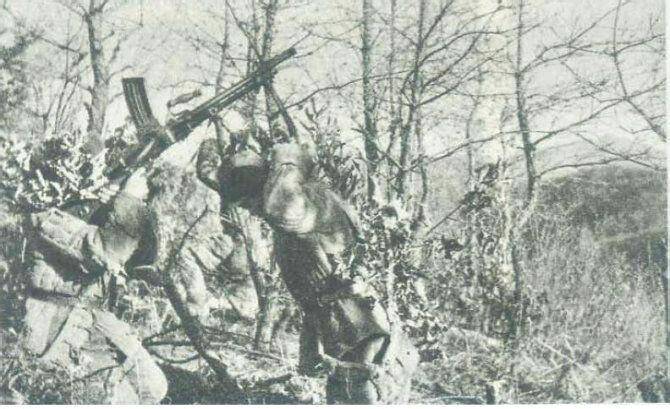
After the introduction of Chinese People's Volunteers in Korea in October 1950, the question of covering them from air strikes arose. From the first days of the participation of Chinese troops in hostilities in Korea and until the conclusion of the armistice in July 1953, rifle-caliber machine guns were actively used against the aviation of the UN forces.
At first, these were captured Japanese Type 96 and Type 99 light machine guns produced at Chinese enterprises ZB-26, Canadian-made Bren machine guns repulsed from the Kuomintang, American M1918A2, Japanese Type 92 machine guns, Chinese clones of the German MG 08 machine gun, American Browning M1917A1 and M1919 ...
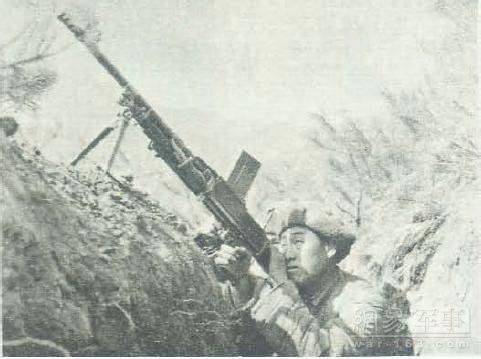
Later, the Soviet DP-27 light machine guns and the SG-43 easel machine guns were added to them. The Chinese infantry units also had a significant number of Maxim machine guns arr. 1910/30 on an infantry wheeled machine. However, due to the large weight and design features of the machine, these machine guns were practically not used for anti-aircraft fire.
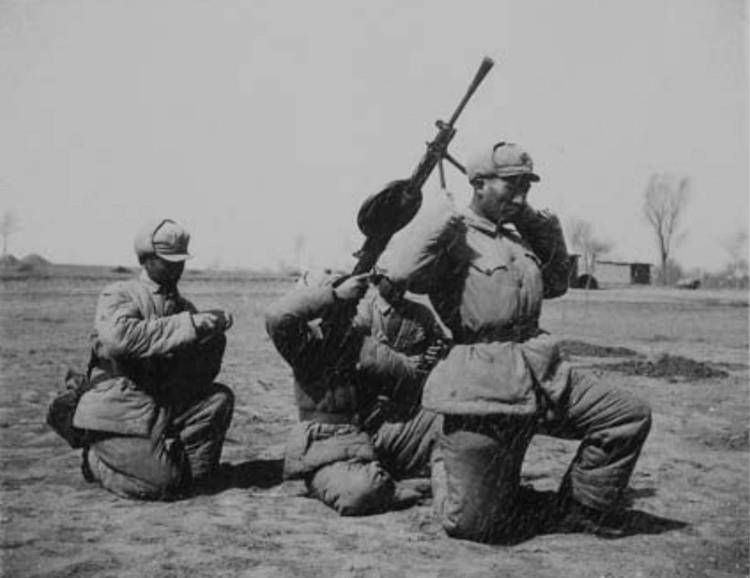
In most cases, the available light machine guns for firing at air targets were operated from improvised supports.
Some of the rifle-caliber heavy machine guns available to the Chinese volunteers allowed anti-aircraft fire from standard machines.
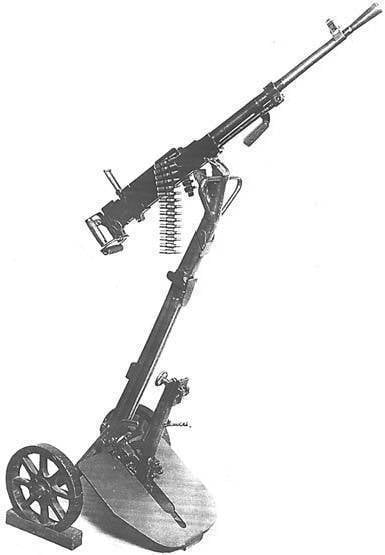
Machine gun SG-43 in position for anti-aircraft fire
According to Chinese sources, captured Japanese Type 1950 13,2-mm anti-aircraft machine guns were used to provide anti-aircraft cover for Chinese infantry units that crossed the Yalu River in the late autumn of 93. But in the spring of 1951, the surviving Japanese-made heavy machine guns returned to China.
By the time China entered the war on the side of the DPRK, the PLA had several dozen 12,7-mm Browning M2NV machine guns. These machine guns were supplied by the Americans to Chiang Kai-shek's troops and became the trophies of the communists after the victory in the civil war.
The Browning M2NV machine gun with a heavy barrel, adopted in 1938, is still in service in the armies of many countries, it can be successfully used against manpower, fight light armored vehicles and hit low-flying air targets. The body weight of the machine gun is 38 kg. Rate of fire 480-550 rds / min. At a distance of 500 m, an armor-piercing 12,7 mm bullet would normally penetrate 16 mm armor.
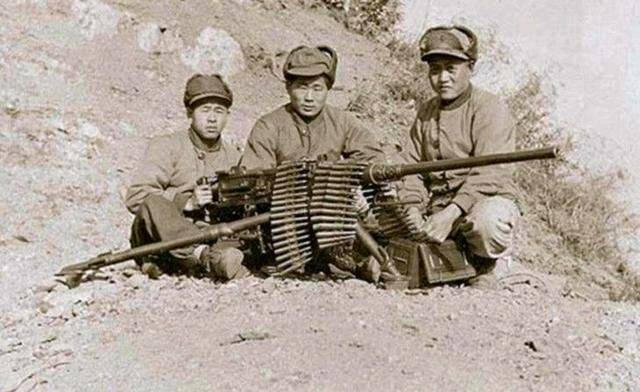
During the fighting on the Korean Peninsula, American-made 12,7-mm machine guns were repeatedly captured by Chinese people's volunteers.
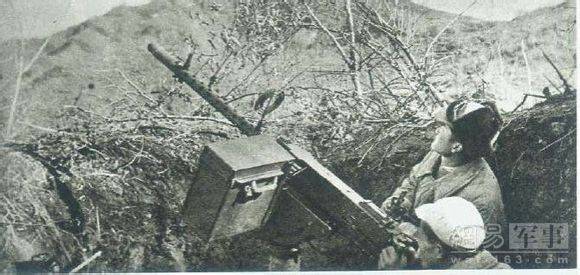
However, trophy large-caliber "Browning" was used to a limited extent for anti-aircraft cover. Shooting at an air enemy required a large expenditure of ammunition and special preparation of calculations, which, after the start of mass deliveries of Soviet 12,7-mm DShK machine guns, did not make much sense.
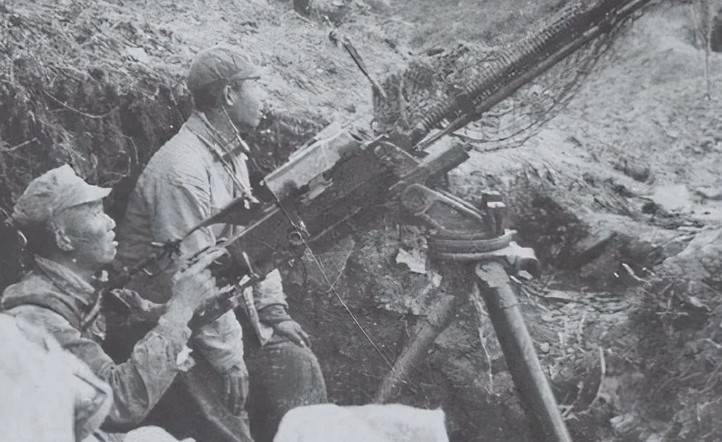
Chinese crew with 12,7 mm DShK machine gun
In terms of combat effectiveness, the DShK was not inferior to the American Browning M2NV, but at the same time the Soviet machine gun was more reliable and easier to operate. The main disadvantage of the 12,7 mm DShK machine gun mod. 1938 was a large mass. The body of the machine gun weighed 33,5 kg. The mass of the machine gun on a universal wheeled machine is 157 kg. Rate of fire - 550-600 rds / min. The maximum range for air targets is 2 m, the effective range is up to 400 m. In terms of armor penetration, the DShK and Browning M1NV were approximately at the same level.
Soviet-made large-caliber DShK machine guns were very widely used in Korea for anti-aircraft cover for Chinese troops.
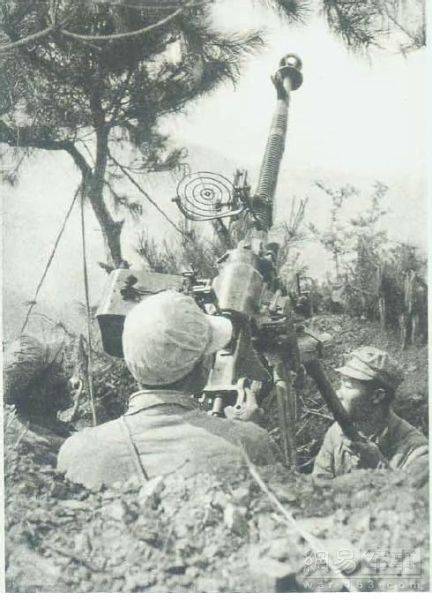
There are many photographs of Chinese calculations from the Korean War period with DShK machine guns prepared for firing at air targets.
Large-caliber anti-aircraft machine guns usually covered places of concentration of troops, battalion and regimental headquarters, warehouses, transport hubs, and small bridges. Attempts to use anti-aircraft DShK installed on trucks to escort transport convoys did not have much success. American attack aircraft and fighter-bombers almost completely blocked transport links in the frontal zone during the day.
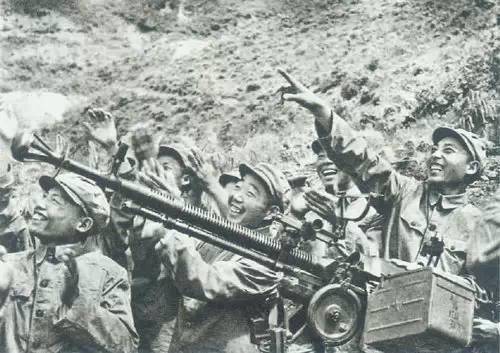
After the front line stabilized, the American command, when planning attacks on Chinese and North Korean positions, had to reckon with the enemy's presence of several hundred large-caliber anti-aircraft machine guns, which posed a mortal threat to fighter-bombers delivering bomb and assault strikes.
Small-caliber rapid-fire anti-aircraft guns
At the initial stage of hostilities on the Korean Peninsula, the Chinese people's volunteers had German and Japanese anti-aircraft guns at their disposal.
Judging by the available photographs and fragmentary information published on the Chinese segment of the Internet, at the beginning of 1951, Chinese people's volunteers used 20-mm 2,0 cm FlaK 30 anti-aircraft guns in Korea.
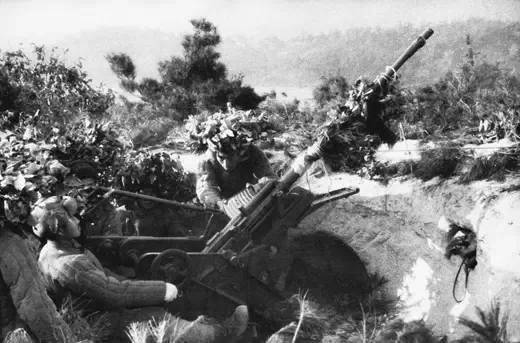
The origin of these 20mm assault rifles is unclear. They could be recaptured from the Kuomintang, or the Chinese communists received them from the USSR from among the trophies captured from the Germans.
During the Sino-Japanese War, the CPC troops were able to recapture several Type 20 98-mm anti-aircraft guns from the Japanese, which were most often installed in the back of trucks and on railway platforms to protect against aviation and attacks from sabotage groups. The Japanese command placed a number of dual-use rapid-fire installations in China along the perimeter of fortified bases.
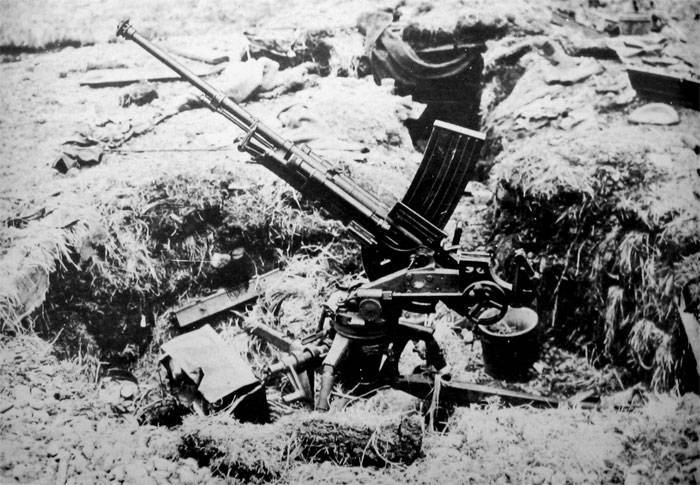
20-mm Type 98 anti-aircraft gun in a firing position
The principle of operation of the Type 98 automatics was repeated by the French 13,2 mm Hotchkiss M1929 machine gun. For shooting from the Type 98, a 20x124 mm shot was used. An armor-piercing tracer projectile with a mass of 109 g left the barrel with an initial speed of 835 m / s and at a distance of 250 m it could penetrate 30-mm armor.
In the combat position, the anti-aircraft gun was hung out on three supports. If necessary, the fire could be fired from the wheels, but the accuracy of the fire dropped. Weight in firing position - 373 kg. Food was supplied from a store for 20 shells. Rate of fire - 300 rounds / min. Combat rate of fire - up to 120 rds / min. The effective firing range against air targets did not exceed 1 m.
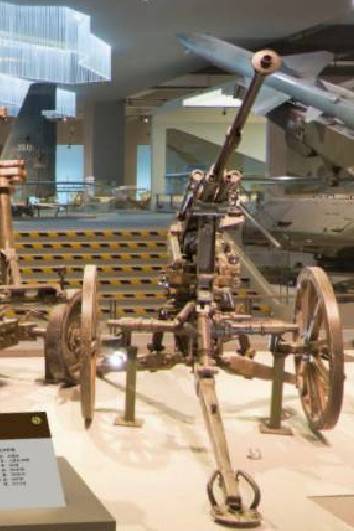
20-mm Type 98 anti-aircraft gun at the War Museum of the Chinese Revolution
After the surrender of the Kwantung Army, the USSR handed over several dozen 20-mm Japanese-made anti-aircraft guns to the troops of Mao Zedong, which in the second half of the 1940s waged an armed struggle against the Kuomintang. A number of Type 98 installations remained in service with the PLA until the mid-1950s. However, in Korea, Japanese-made 20-mm anti-aircraft guns were used very limitedly and only at the initial stage of the war.
During World War II, the most common in the Japanese armed forces were 25-mm anti-aircraft guns. Until August 1945, about 33 000-mm Type 25 anti-aircraft guns were produced.
The Type 96 artillery unit was developed in 1936 on the basis of the Mitrailleuse de 25 mm contre-aéroplanes gun of the French company Hotchkiss. The most serious difference between the Japanese model and the original was the equipment of the German company Rheinmetall with a flame arrester. In addition to the Type 96 single-barreled anti-aircraft guns, during the Second World War in Japan, twin and triple anti-aircraft guns were also produced.
Single-barreled and twinned 25-mm anti-aircraft guns were used mainly on land, while triple-barreled ones were installed on ships and stationary positions. Single-barreled units were often transported in the back of a truck, and paired ones were towed by vehicles with a carrying capacity of at least 1,5 tons.
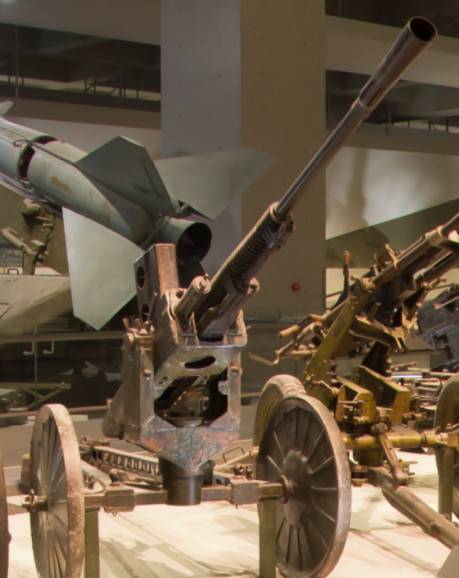
25-mm Type 96 anti-aircraft gun at the Military Museum of the Chinese Revolution
A single-barreled 25-mm anti-aircraft gun weighed 790 kg and could be rolled by a crew of 4 people. In the combat position, the wheel drive was separated. Food was supplied from a store for 15 shells. Rate of fire - up to 250 rds / min. Practical rate of fire - up to 120 rds / min. Effective firing range - up to 3 m. Height reach - 000 m.
Used ammunition dimension 25x163 mm. The ammunition load could include: high-explosive incendiary, fragmentation tracer, armor-piercing, armor-piercing tracer shells. At a distance of 250 meters, an armor-piercing projectile weighing 260 g with an initial speed of 870 m / s pierced 35 mm armor.
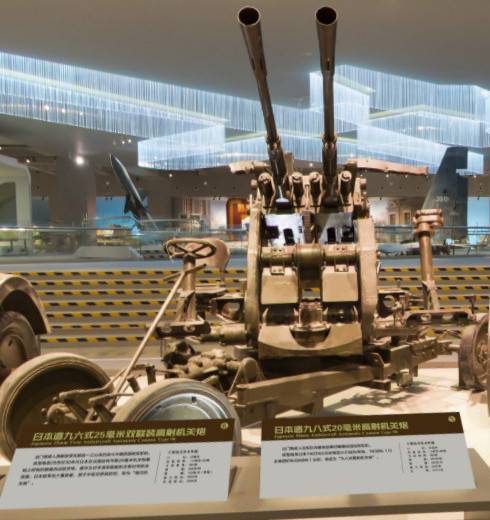
Japanese twinned 25mm anti-aircraft gun at the War Museum of the Chinese Revolution
The twinned 25-mm unit was mounted on a four-wheeled vehicle with a detachable wheel travel. Its weight in combat position was 1 kg. Calculation - 110 people.
After the surrender of the Kwantung Army, among the trophies taken by the Red Army, there were about 400 single-barreled and paired 25-mm anti-aircraft guns and a significant amount of ammunition. Most of these anti-aircraft guns with ammunition were donated to the Chinese communists.
Subsequently, the Type 96 installations were used against the Chiang Kai-shekists and during the hostilities on the Korean Peninsula. Captured Japanese 25-mm anti-aircraft guns were in service with the PLA until the second half of the 1950s, when they were finally supplanted by Soviet and Chinese anti-aircraft guns.
By the beginning of the Korean War, the PLA had more than 250 operational 25-mm Japanese anti-aircraft guns, and they actively fought until the summer of 1951. After that, the Type 96 installations were taken to the deep rear. After several months of active use, a shortage of 25-mm shells began to be felt, and many anti-aircraft guns needed repair.
The main burden of protecting Chinese units from air strikes fell on 37 and 85-mm Soviet-made anti-aircraft guns, the mass delivery of which began shortly after the entry of PLA units into Korea.
Chinese anti-aircraft artillery units deployed in the DPRK in February 1951 were armed with more than a hundred 37-mm automatic anti-aircraft guns of the 1939 model (61-K). Subsequently, their number reached 300 units. Soviet 37-mm machine guns quickly ousted 20 and 25-mm anti-aircraft guns in units fighting in Korea.
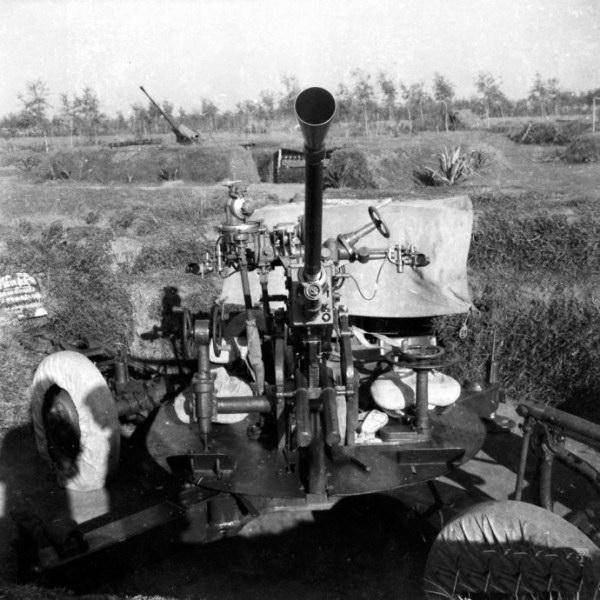
37-mm anti-aircraft gun model 1939 in a firing position
A number of sources say that the Soviet Union, in addition to the 37-mm anti-aircraft guns mod. 1939, also handed over to the PRC a batch of 40-mm Bofors L60 installations, received by the Soviet side under Lend-Lease during the Second World War. But it was not possible to find confirmation of this information.
The Soviet 37-mm automatic anti-aircraft gun was created on the basis of the Swedish 40-mm Bofors anti-aircraft gun and was very close to it in terms of its characteristics. Until 1947, more than 18 000-mm anti-aircraft guns mod. 37.
37-mm anti-aircraft gun mod. 1939 of the year could hit air targets at a distance of up to 4 m and an altitude of 000 m. The effective range of anti-aircraft fire was approximately half the size. Rate of fire - 3 rounds / min. The mass of the gun in a combat position without a shield was 000 kg. Calculation - 160 people.
The 61-K anti-aircraft guns were the most effective ground-based air defense weapons available to the Chinese People's Volunteers. One hit of a 37-mm fragmentation-tracer projectile into a single-engine combat aircraft in most cases was enough to destroy it or ensure its incapacitation.
These 37-mm guns had a sufficiently high rate of fire, accuracy, range and height reach to force piston and jet combat aircraft that deliver missile and bomb strikes against point targets to abandon their combat missions in the zone of effective fire.
With the proper level of preparation, the calculations of 37-mm assault rifles in a number of cases managed to achieve high results. So, in the course of repelling enemy air raids on Kaesong, a separate 11th anti-aircraft artillery battalion of the Chinese Volunteer Army shot down 35 American aircraft. According to the official Chinese version, the calculation of one anti-aircraft gun hit 10 aircraft.
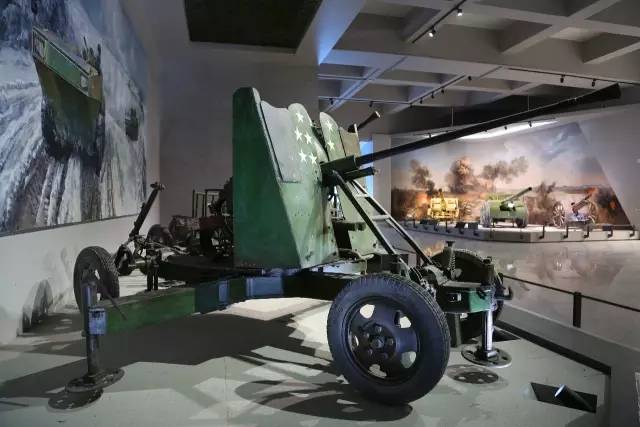
Z7-mm automatic anti-aircraft gun mod. 1939 at the War Museum of the Chinese Revolution
To what extent this is true is unknown. In a battle, when all the anti-aircraft guns of a battalion are firing at enemy aircraft, it is impossible to determine whose shell hit this or that target. Nevertheless, the 37-mm cannon mod. 1939 with 10 stars on a splinter shield is displayed at the Military Museum of the Chinese Revolution in Beijing.
75 and 85 mm anti-aircraft guns
At the initial stage of the introduction of Chinese troops into Korea, 75-mm Japanese-made Type 88 anti-aircraft guns were used to provide cover from bombers operating at medium and high altitudes.
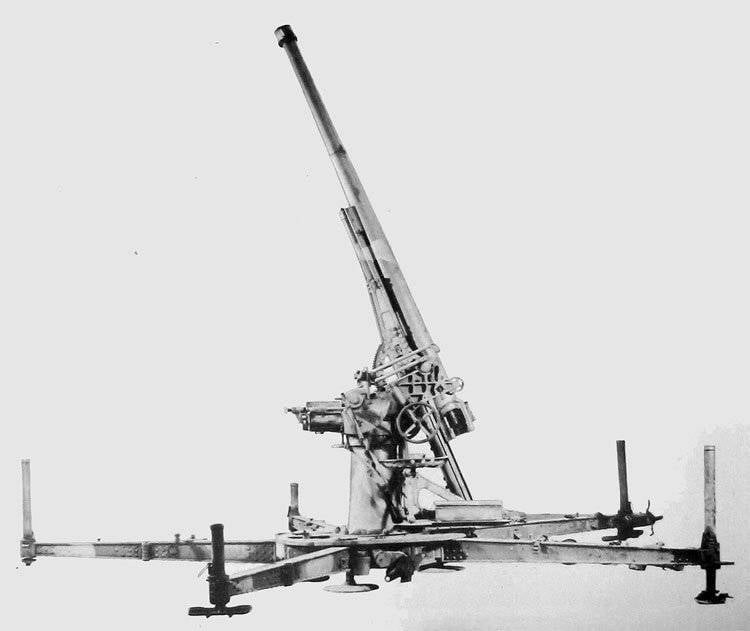
75-mm anti-aircraft gun Type 88 in firing position
The 75 mm Type 88 anti-aircraft gun was adopted by the Imperial Japanese Army in 1928. In the transport position, the Type 88 gun weighed 2 kg, in the combat position - 740 kg.
The process of transferring from transport to combat position and vice versa was very time consuming. Particularly inconvenient for deploying an anti-aircraft gun in a combat position was such a structural element as a five-beam support, in which it was necessary to move four beds apart and unscrew five jacks. Dismantling two transport wheels also took a lot of time and effort from the crew.
The maximum reach in height was 9 km, the range for anti-aircraft fire was 12 km. Rate of fire - up to 20 rounds / min.
In addition to a fragmentation grenade with a remote fuse and a high-explosive fragmentation projectile with a shock fuse, the ammunition load could include an armor-piercing projectile weighing 6,2 kg. Having left the barrel with an initial speed of 740 m / s, at a distance of 500 m, when hit at a right angle, an armor-piercing projectile could penetrate 110 mm thick armor.
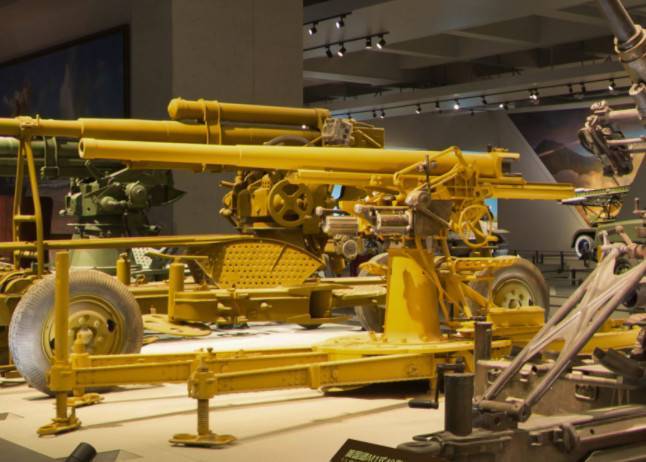
75-mm anti-aircraft gun Type 88 at the Military Museum of the Chinese Revolution
The first anti-aircraft unit equipped with 75mm Type 88 guns appeared in the Northeastern CPC Army in March 1946. The 16th Anti-Aircraft Artillery Brigade of the Liaodong Military District had 75-mm Japanese-made anti-aircraft guns, German and Japanese 20-mm machine guns, as well as 13,2-mm Japanese anti-aircraft machine guns.
This unit provided air defense for the cities of Harbin, Jiamusi, Mudanjiang and Jilin.
During the siege of Changchun, a Kuomintang C-75 transport aircraft was shot down by 47-mm anti-aircraft guns. In 1949, Type 88 guns were used in the air defense of Wuhan and Guangzhou. In the spring of 1950, they participated in the battle for the liberation of Hainan Island, defending the troops and ships concentrated on the coast near Xuwen.
By the time the Chinese people's volunteers entered Korea, the PLA had two anti-aircraft artillery regiments armed with Type 88 anti-aircraft guns. Although these 75-mm anti-aircraft guns were pretty outdated by the early 1950s, the Chinese used them for lack of a better one.
A major drawback of the Type 88 guns was that their height reach did not allow firing at American B-29 Superfortress heavy bombers flying at an altitude of 9 m. In addition, the fragmentation effect of 000-mm shells was relatively small, and Japanese remote fuses did not differ high reliability.
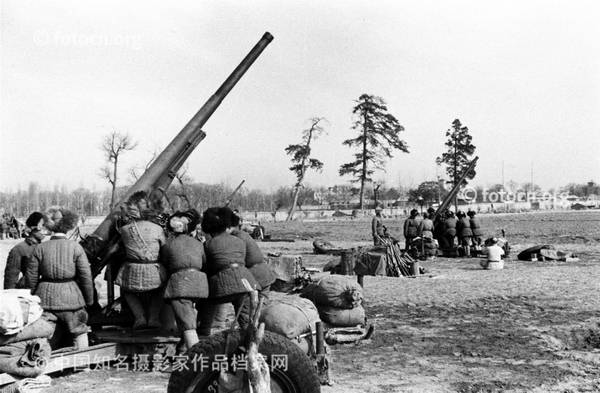
On October 8, 1950, two divisions of 75-mm anti-aircraft guns crossed the Yalu River in the Kuandyan district to take part in hostilities in the DPRK. Another division was deployed on the Chinese side of the river to cover the ferry and the railway bridge.
Although the effectiveness of the Type 88 guns was low, the presence of anti-aircraft cover in the area of the Yala crossing limited the activity of American aviation. In Korea, part of the 75-mm batteries were placed on the tops of the hills, which gave the best opportunities for firing low-flying aircraft.
In early 1951, anti-aircraft units equipped with 75 mm Type 88 guns returned to China. The anti-aircraft regiment arrived in the city of Jinzhou, where the 61st and 62nd anti-aircraft artillery divisions were created on its base. Each division had one regiment equipped with 85mm anti-aircraft guns and two regiments with 37mm machine guns. Each anti-aircraft artillery regiment had 16 85 mm or 32 37 mm cannons and 12 to 16 12,7 mm anti-aircraft machine guns. By the end of 1952, the 63rd, 64th and 65th anti-aircraft divisions were additionally formed.
After mastering the 85-mm Soviet anti-aircraft guns KS-12 mod. In 1944, the capabilities of the Chinese air defense in terms of countering combat aircraft flying at medium and high altitudes increased significantly.
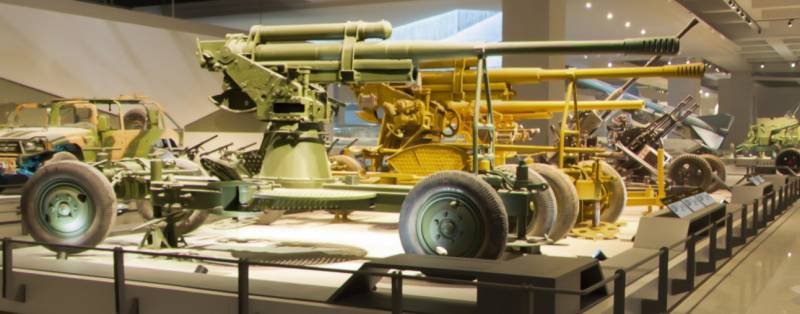
85mm anti-aircraft guns at the Museum of the Chinese Revolution
The KS-12 gun was created after comprehending the experience of the combat use of the 85-mm anti-aircraft gun 52-K mod. 1939. The new 85-mm anti-aircraft gun has become easier and cheaper to manufacture. Due to an increase in the mass of the powder charge in the case and a longer gun barrel, the initial velocity of the projectile weighing 9,2 kg increased from 800 to 870 m / s, which increased the range and reach in height. The mass of the gun in the firing position was about 5 kg. Height reach - up to 000 km. A well-trained crew could fire up to 12 shells in a minute.
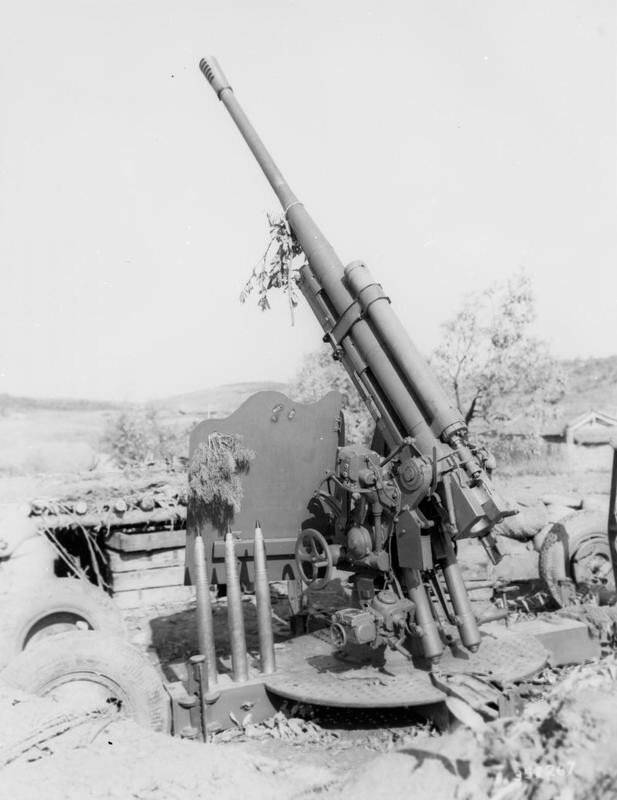
The 85-mm KS-12 was a completely modern anti-aircraft gun for that time. Its range and reach in height, even in a small radius of action, was still enough to fire on American B-29 bombers. In addition, the area of the fragmentation field generated by the detonation of an 85-mm grenade was approximately 1,5 times larger than the 75-mm projectile of the Type 88 anti-aircraft gun.
Combat use of Chinese anti-aircraft artillery in Korea
At the first stage (October 1950 - June 1951), the Chinese anti-aircraft artillery did not differ in high efficiency, although it had a certain chilling and deterrent effect on the aviation of the UN forces. Medium-caliber anti-aircraft guns were used to cover important objects: airfields, railway stations and bridges.
Small-caliber rapid-fire anti-aircraft guns of three divisions, armed with 20-25-mm machine guns and 13,2-mm machine guns, were most often located closer to the front line and for the most part fired at American combat aircraft operating at low altitudes.
From January to April 1951, the 61st, 62nd, 63rd and 64th anti-aircraft artillery divisions, the 524th anti-aircraft artillery regiment and 30 separate anti-aircraft artillery divisions arrived in the DPRK. Each division had 12 rapid-fire 37 mm anti-aircraft artillery mounts and 4 12,7 mm machine guns.
Separate anti-aircraft battalions mainly covered the Chinese troops in the front line.
Faced with the fire of small-caliber artillery guns and large-caliber anti-aircraft machine guns, American pilots began to avoid low-altitude attacks, drop bombs and launch NAR from an altitude of at least 1 m, which reduced the effectiveness of airstrikes and did not allow aimed fire from aircraft machine guns. The cruising altitude was at least 500 m.
Batteries of 85 mm anti-aircraft guns created a danger zone at medium altitudes within a radius of 8 km.
In the second stage (July 1951 - July 1953), the number of Chinese anti-aircraft artillery deployed on the Korean Peninsula increased dramatically.
According to Chinese sources, by the time of the ceasefire, the air defense of ground units in the frontline zone and rear North Korean facilities was provided by 5 anti-aircraft divisions (61st, 62nd, 63rd, 64th and 65th), 21 anti-aircraft artillery regiment and 64 separate anti-aircraft artillery battalions.
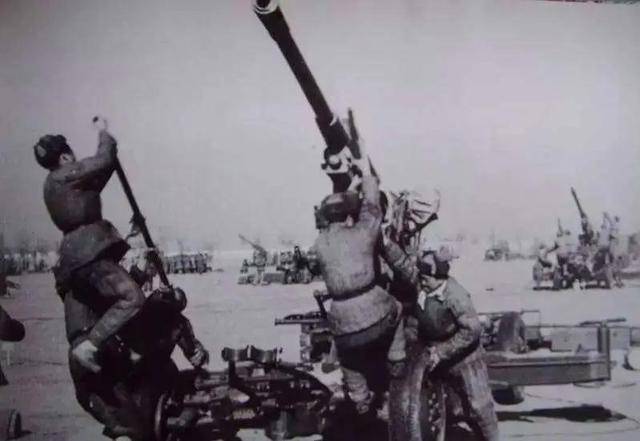
In August 1951, the American command, taking advantage of the flooding in the DPRK, aimed up to 80% of its aviation to organize an air blockade. The main targets were railway stations and bridges.
The command of the Chinese forces in North Korea had to send most of the anti-aircraft guns to protect stations and bridges.
In the second half of 1952, the Americans, having failed to achieve victory on the battlefield, reoriented strike aircraft to air attacks on important industrial enterprises, bridges, large warehouses and transport hubs located in the depths of the DPRK.
When covering rear objects, the Chinese used a combination of stationary positions with the organization of anti-aircraft ambushes on the routes of enemy aircraft.
Quite often, the battles of the Chinese anti-aircraft gunners with enemy aircraft took on a fierce character. So, in the battle of Shanganling (November-December 1952), the 601st anti-aircraft artillery regiment, as well as the 20th and 35th separate anti-aircraft artillery battalions, shot down 43 and knocked out 50 enemy aircraft within 154 days.
Faced with strong anti-aircraft resistance, American bombers went into action at night.
In this situation, searchlights and radars began to play an important role. The combat work of the Chinese anti-aircraft artillery units was provided by 5 searchlight battalions, 2 air surveillance regiments and 1 radar battalion.
The main goal of anti-aircraft artillery and searchlights was not so much the destruction of enemy aircraft as disrupting the execution of a combat mission by enemy aircraft, preventing them from reaching guarded objects and forcing them to leave the battlefield or drop bombs anywhere, without reaching their targets.
Another way to protect objects from attacks by enemy bomber aviation was the setting of barrage fire, which consisted in creating a high-density fragmentation curtain along the front, depth and height. Which, in turn, led to an increased consumption of anti-aircraft shells.
Until the second half of 1951, a situation often developed when the anti-aircraft batteries of the Chinese People's Volunteers could not open fire due to the lack of ammunition.
The Soviet Union ensured the delivery of the required amount of ammunition to the PRC, but the American twin-engine B-26 Invader bombers, operating in the dark, actively interfered with the regular supply. These aircraft hunted down transport convoys carrying supplies to the front lines. They fired heavy machine guns at cars and trains, dropped bombs and napalm tanks.
One of the most successful countermeasures against road-hunting night pirates has been the creation of nomadic anti-aircraft groups consisting of a searchlight platoon and a battery of 37mm cannons.
Each such group received its own road sections and changed positions every day. The enemy, not knowing where he would meet fire this time, was forced to raise the flight altitude, which immediately negatively affected the effectiveness of dropping bombs and napalm tanks.
In the end, this is the main thing weapon The B-26 lost its effectiveness, and machine gun fire became useless altogether.
Anti-aircraft artillery played a very important role not only in the defense, but also in the offensive.
In May 1953, the Chinese command deployed 18 anti-aircraft artillery regiments and 5 separate anti-aircraft artillery battalions in addition to the 14 anti-aircraft battalions available in the frontline zone to cover the advancing units of the first line. Thanks to this, the density of 13 anti-aircraft guns per kilometer was achieved in the offensive zone.
Anti-aircraft artillery was mainly used to cover places of concentration of troops before an attack, command posts, artillery positions, bridges, warehouses and other targets in the depth of the defense, as well as to provide offensive actions. The main focus was on stopping attacks by American fighter-bombers and countering enemy aircraft conducting reconnaissance and correcting artillery fire.
Anti-aircraft artillery units repelled more than 5 air attacks and shot down 000 enemy aircraft, allowing Chinese artillery to fire from undefended positions, while transport convoys were able to deliver supplies to advancing troops without hindrance.
After re-equipping with Soviet-made anti-aircraft guns, gaining the necessary experience and qualifications by calculations, Chinese anti-aircraft artillery became a formidable force that had a significant impact on the course of hostilities. According to information published in the PRC, the anti-aircraft artillery of the Chinese people's volunteers shot down more than 2 enemy aircraft in Korea.
The experience gained during the war on the Korean Peninsula had a decisive influence on the further development of the air defense of the People's Liberation Army of China.
Продолжение следует ...
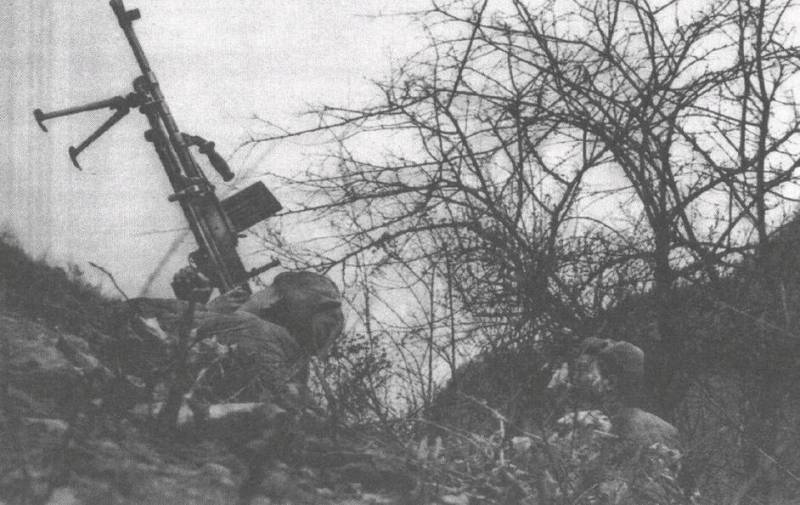
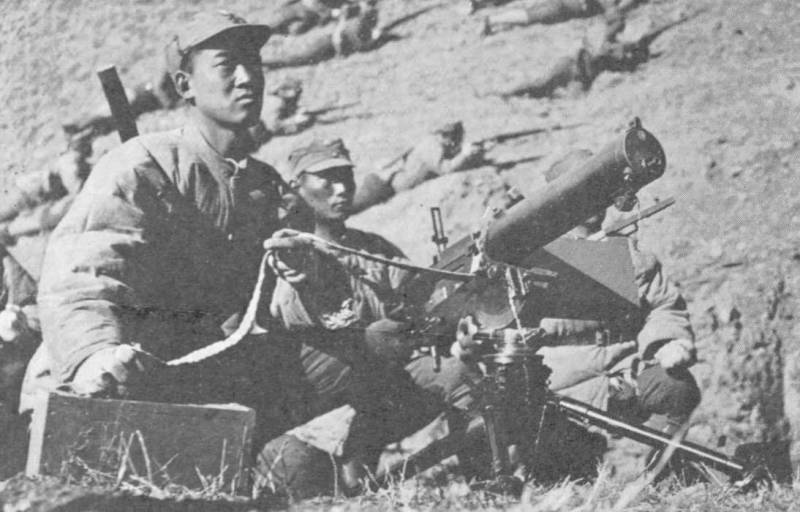
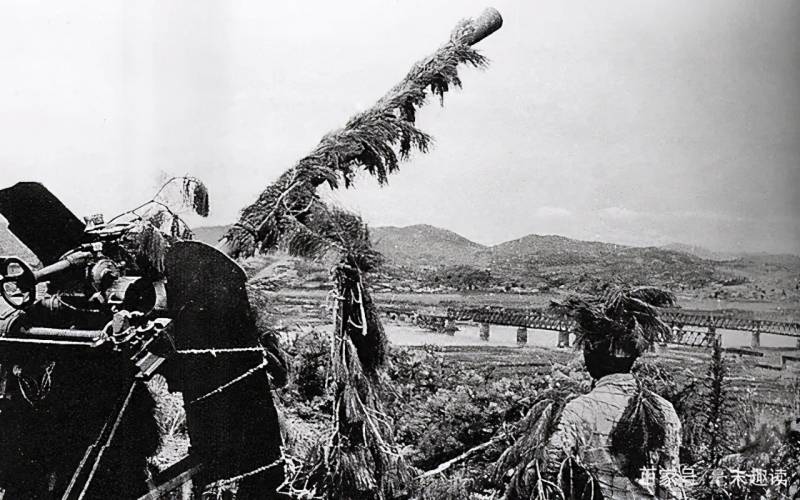
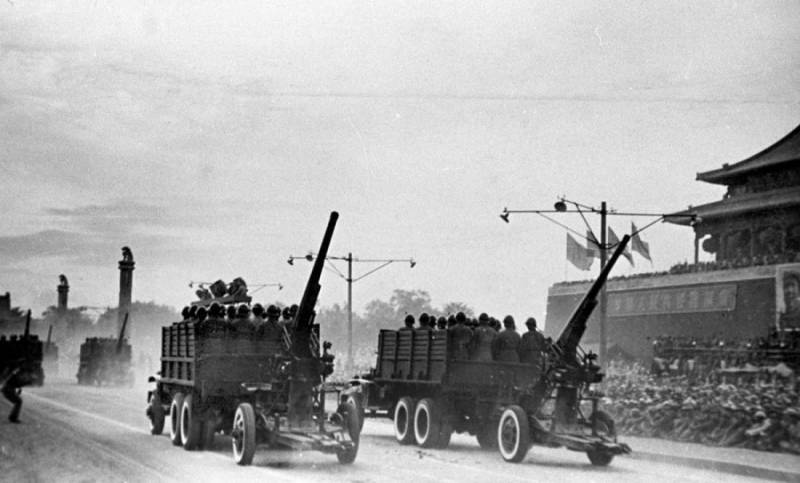
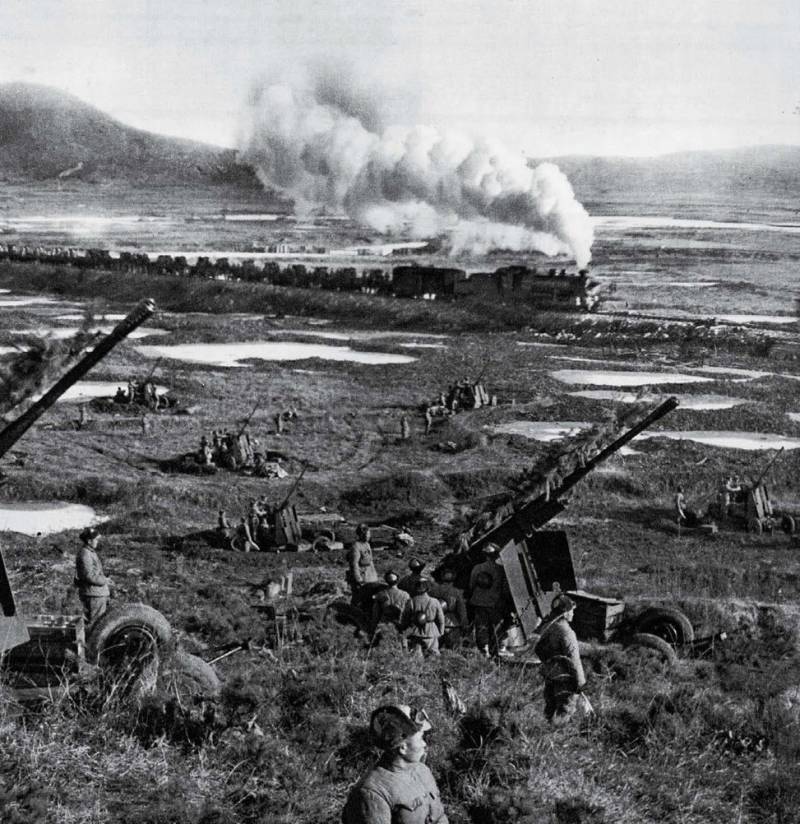
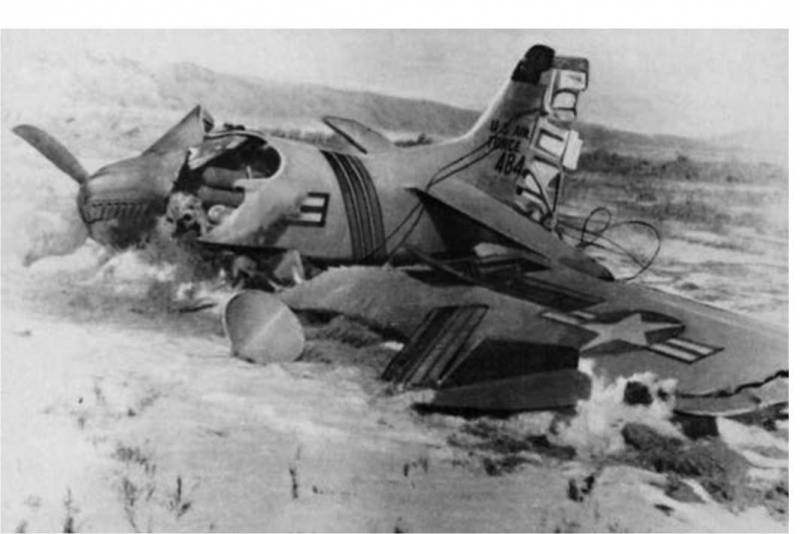
Information